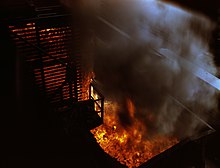The floor is lava
 From Wikipedia the free encyclopedia
From Wikipedia the free encyclopedia

The floor is lava is a game in which players pretend that the floor or ground is made of lava (or any other lethal substance, such as acid or quicksand), and thus must avoid touching the ground, as touching the ground would "kill" the player who did so.[1] The players stay off the floor by standing on furniture or the room's architecture.[1] The players generally may not remain still, and are required to move from one piece of furniture to the next. This is due to some people saying that the furniture is acidic, sinking, or in some other way time-limited in its use. The game can be played with a group or alone for self amusement. There may even be a goal, to which the players must race. The game may also be played outdoors in playgrounds or similar areas.
This game is similar to the traditional children's game "Puss in the Corner", or "Puss Wants a Corner", where children occupying the corner of a room are "safe", while the Puss, the player who is "It" in the middle of the room, tries to occupy an empty corner as the other players dash from one corner to another. This game was often played in school shelter-sheds in Victoria, with the bench-seats along the walls of the shelter-shed being used as platforms joining the corner, while players crossing the floor could be caught by the Puss.
Gameplay[edit]
This section needs additional citations for verification. (September 2023) |
Typically, any individual starts the game just by shouting "The floor is lava!" Any player remaining on the floor in the next few seconds would be "out".[2]
There often are tasks, items or places that can "regenerate" lost body parts or health. Depending on the players, these could be embarrassing tasks, or simple things like finding a particular person. Players can also set up obstacles such as padded chairs to make the game more challenging; this is a variation of an obstacle course.
In one version called "Hot Lava Monster", sometimes referred to as "Skies in the Ringuss", usually played on playgrounds, players must stay off the ground (sand, rubber, woodchips, etc.) and on the play equipment. The person who is playing the "monster" can be on the 'lava' with the objective of attempting to tag another player. The "monster" must try to tag or catch the other players. In some versions, the "monster" is not allowed to touch certain obstacles, such as wooden platforms or may only touch objects of a certain colour. The "monster" must navigate across structures such as across playground slides, monkey bars, ropes courses, etc. instead of the main platform.
Origin[edit]
An 2018 preprint on Social Science Research Network suggested the game originates from a rise of living rooms populated with furniture during late 1930s. The living room's ubiquitous nature and the game's simplicity allowed the game to rapidly spread from peer to peer.[3]
Adaptations into media[edit]

In 2020, Netflix released a TV show based on the game called Floor Is Lava, where three teams compete to win $10,000 in different challenges.[4][5]
References[edit]
- ^ a b Fosberry, Deven; Lakhotia, Pratik (2014). "Playing 'The Floor is Lava' in Real Life". Journal of Interdisciplinary Science Topics. 3. University of Leicester: 37–38. ISBN 9781291898965 – via Google Books.
- ^ Foley, Katherine Ellen (2018-05-23). ""The Floor Is Lava" shows how US suburban architecture changed the way American kids play". Quartz. Retrieved 2023-08-21.
- ^ Hwang, Tim (2018). "On the Architecture of the Folk Game: The Case of 'The Floor is Lava'". SSRN Electronic Journal. doi:10.2139/ssrn.3122458. ISSN 1556-5068. S2CID 149313300.
- ^ Kwong, Matt (July 23, 2020). "Saucy, Slimy, Super-Secret: Behind The Scenes With 'Floor Is Lava' Star ... Lava". NPR.
- ^ Spencer, Samuel (June 23, 2020). "'Floor is Lava' on Netflix: What the Lava is Made Out Of". Newsweek. Retrieved November 27, 2022.